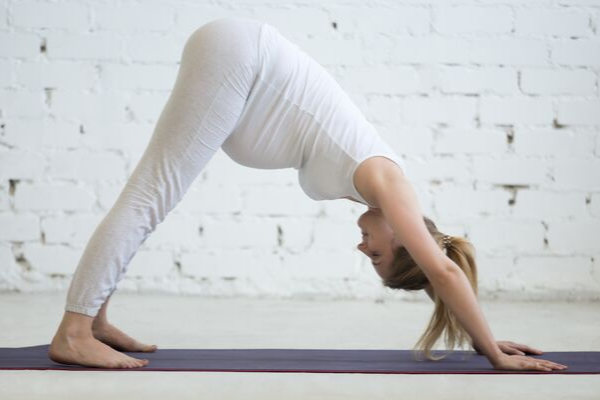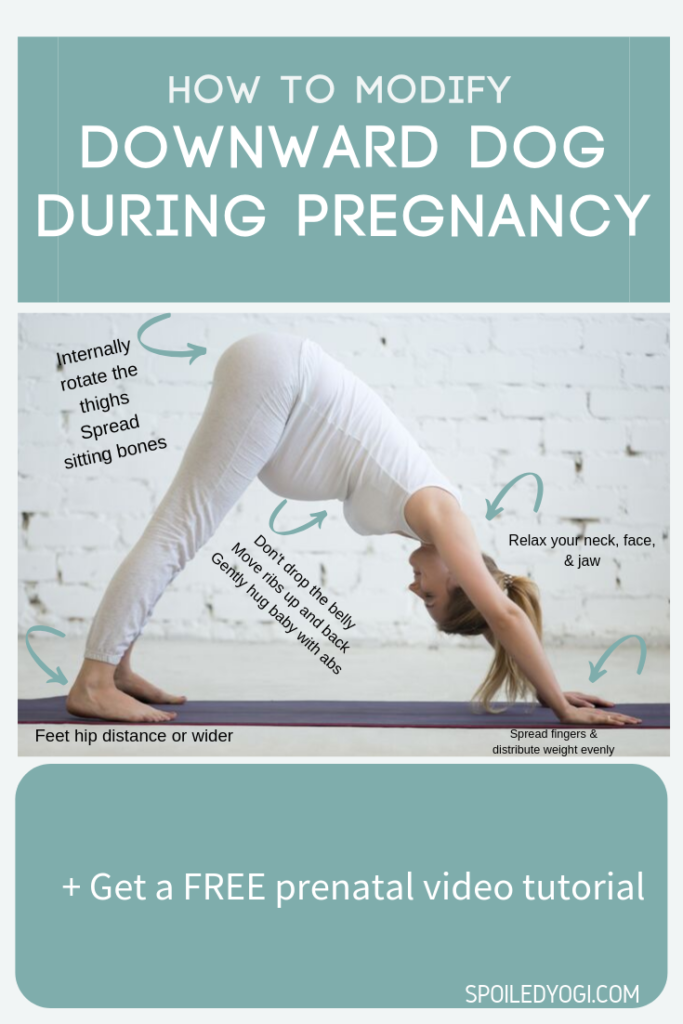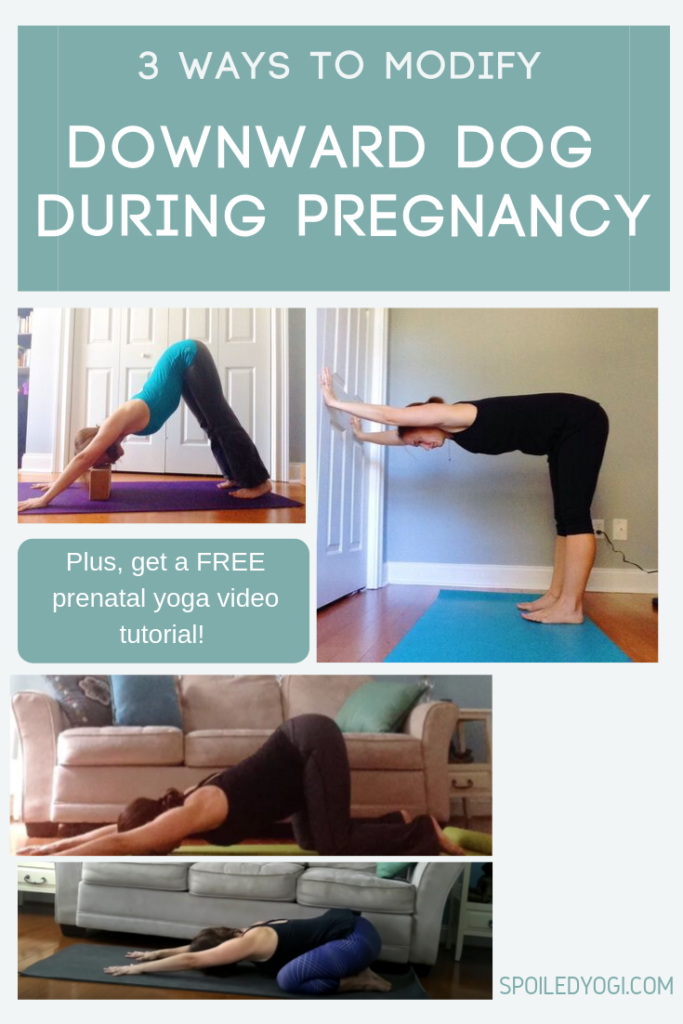
Downward Facing Dog (Adho Mukha Svanasana in Sanskrit) is one of the most common yoga poses. It’s so ubiquitous that you can expect to practice it at least once in pretty much every yoga class. So, if you happen to be a pregnant yoga student, you might be wondering how to do the pose safely and make it work for your growing baby bump without disrupting the flow of the class. I’ve got you, Mama.
In this post, I’ll go over the basics of Downward Facing Dog modifications for pregnancy. (Rest assured, for most pregnant women, Downward Dog is safe. More on that later.)
But, if I’ve said it once, I’ve said it a million times. Just because something is considered safe during pregnancy, doesn’t mean it’s the best thing for your body in any given moment.
I’ll also be sharing some alternatives for Downward Facing Dog for any time when your all-powerful mama intuition tells you to skip it. (Always listen to that little whisper, Mama. It is magical, and it will keep you safe!)
Is Downward Facing Dog Safe During Pregnancy?
In short, yes. As long as you make a couple tiny modifications (see below), Downward Facing Dog is safe during pregnancy—and it can have some benefits, too.
In fact, a study from 2015 published in the journal Obstetrics & Gynecology found that healthy women had no negative effects for mom or baby from practicing Downward Facing Dog during pregnacy. (The study round that women who participated in this study were fine during Happy Baby and Savasana, too—two poses that pregnant women are often cautioned to avoid or modify.)
It’s important to note, however, that the women who participated in this study were having normal, healthy pregnancies with no complications. The researcher cautioned that all women should check with their OB/Gyns before starting any exercise routine.
And here’s my caveat. Listen to your body and adjust accordingly. There are plenty mamas who have taken my prenatal yoga classes here in Charleston, SC who have not felt great in Down Dog toward the end of their pregnancies. If that becomes the case, there’s no reason to force your body into a shape that doesn’t feel great.
If you try Downward Dog and it feels wrong for any reason, make sure you’re modifying for baby (see blow) or skip down to the next section of this post for some alternative ideas for Down Dog during pregnancy.
How to Modify Downward Facing Dog during Pregnancy

Downward Dog looks pretty different for women at different stages of pregnancy.
In the first trimester there’s really no need to modify. As your baby bump starts to grow, though, you’ll want to widen your feet a bit to make room. As baby grows, your feet have to go wider. By the end of their pregnancies, many moms have their feet as wide as the mat or even a bit wider so that the forward fording action of Downward Dog doesn’t compress the belly and make things uncomfortable.
As your belly grows, you might also notice that the weight of your baby starts to draw your belly down to the floor causing a big curve in your spine. If you’re experiencing that, keep the knees bent slightly and work your ribs in and back a bit (toward the ceiling) so you can find maximum length in your spine as you practice the pose.
Other reasons to modify (or skip) Downward Dog during pregnancy:
Exhaustion.
If you’re super exhausted, which is common in both the first and third trimesters, you might consider choosing a more passive version of the pose. Try bringing your head onto a block. Or choose an alternative version like Child’s Pose.
Acid Reflux.
Poses like Down Dog and Uttanasana (Standing Forward Bend) can make acid reflux worse.
Carpal Tunnel.
Did you know that pregnancy can make carpal tunnel worse? When I was pregnant, I would wake up in the middle of the night because my hands were numb and tingly. Many of the mamas in my prenatal yoga class feel discomfort and pain in their wrists during weight bearing poses like Down Dog.
If you don’t find relief from elevating the heels of your hands on a wedge or a partially rolled mat (so there’s less pressure on the heels of your hands and more toward the fingertips) modify by keeping your knees on the floor in Puppy Pose or skip it and do Child’s Pose instead.
A Gut Feeling.
Sometimes you can’t put your finger on why something doesn’t feel quite right–it just doesn’t. In that case, it’s a good idea to err on the side of caution. It’s so easy to take an alternative position.
3 Alternatives to Downward Facing Dog during Pregnancy
Downward Facing Dog at the Wall
This is a great option for anyone who wants to give their wrists a break, wants to feel a bit more weightless in the posture, or if acid reflux makes it too uncomfortable to forward bend.
Try this:
Stand facing a wall with your feet a bit wider than hip distance apart. Bring your hands to the wall right in front of your shoulders and spread your fingers.
Take a full, deep breath in. As you exhale walk your feet and hips toward the middle of the room, hinge at the hips, and slide your hands down the wall until your hips are at an approximate right angle.
Press the wall with your hands so you feel your spine elongate.
Puppy Pose
This is a great modification for when you want to keep up with the pace of your yoga class, but also feel like you want a little less weight on your hands and wrists.
Try this:
Come into a table top position with your hands and knees on the floor. Then, keep your hips stacked over your knees but walk your hands out in front of you as forward as you can get them.
Keep your elbows straight and as you press your hands into the floor, feel the undersides of your arms lift. (This is the same action you practice in Downward Facing Dog.)
Don’t let your belly sink toward the floor here. Keep the ribs gently pulling up and back so you feel the abdominals gently hug your baby.
Extended Child’s Pose
Need a break? This version of Child’s Pose will give you many of the same benefits of Downward Facing Dog, but will let you rest and restore at the same time. (BONUS: It’s more of hip opener than Down Dog, too!)
Try this:
From your table top position, wider your knees at least as wide as your yoga mat. Bring your big toes to touch and sit your hips back to your heels. Bring your forehead to rest on your mat.
Then, walk your hands as far forward as you can get them so your elbows are straight. Spread your fingers apart and press your palms into the floor so much that the undersides of your arms start to lift up slightly.


This blog is such a wonderful resource to mamas out there! I’ll be saving it for when I get kids.
I’m so happy to hear it, Camilla! Please share it with any friends you might have who are expecting or new moms, too! <3